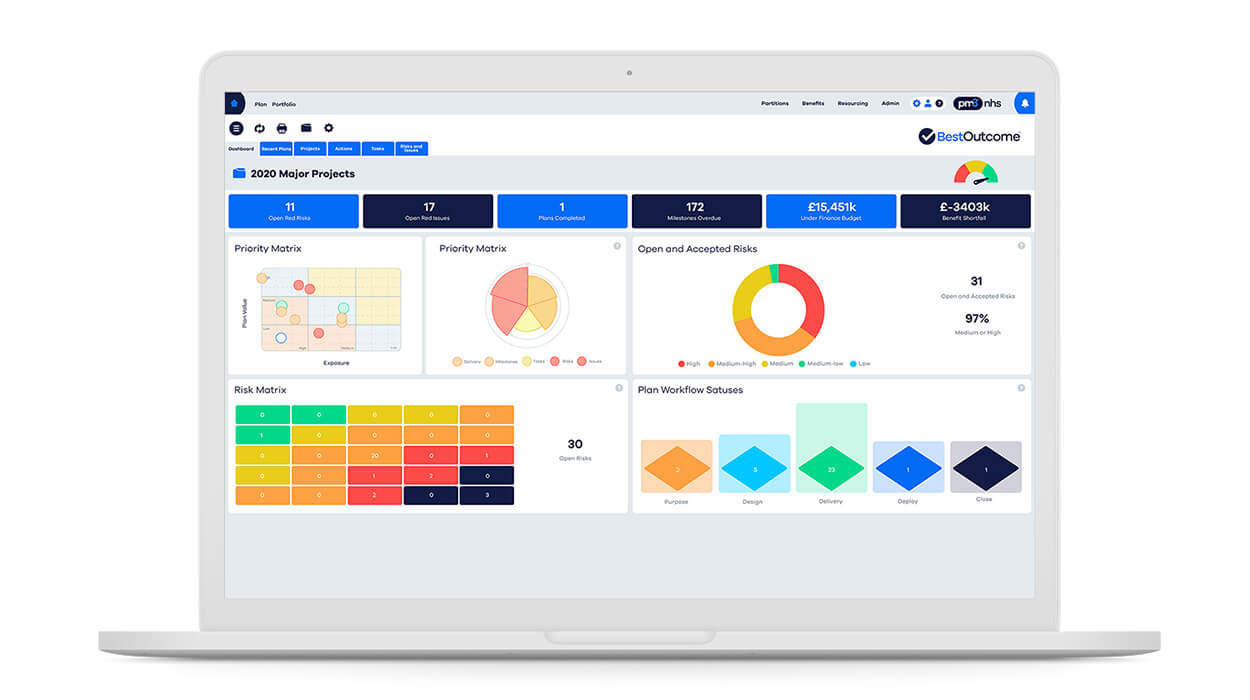Project portfolio management (PPM) is a crucial strategy for any business looking to optimize project outcomes and align them with wider goals.
Yet despite its significant benefits, many organizations still don’t fully understand what PPM really involves or how it’s different from regular project or program management.
This guide addresses that gap by offering a clear introduction to PPM, outlining its advantages, key processes involved and best business practices, including the use of specialized PPM software.
Project portfolio management (PPM) is a strategic approach used by organizations to prioritize projects, optimize resources and align initiatives with overall business objectives.
According to the Project Management Institute (PMI), PPM ‘focuses on doing the right projects at the right time by selecting and managing projects as a portfolio of investments’.
As a business strategy it is fundamentally different from project and program management, which are more about managing execution and delivery.
Instead, PPM involves evaluating potential projects by their expected returns, resources required and their alignment with your strategic goals.
It’s a methodology designed to ensure that you can achieve maximum efficiency, effectiveness and profitability by managing a whole portfolio of different projects as one single entity.

While often related, project management, program management and project portfolio management are distinct disciplines.
Understanding their differences and how they complement each other is crucial for effective project governance.
Project management is primarily focused on the successful delivery of individual projects. It involves the application of knowledge, skills, tools and techniques to project activities to meet the project requirements.
Project management is concerned with managing the scope, cost and time of individual projects, ensuring they are completed on schedule, within budget and to the specified quality standards.
The primary aim is to achieve specific short-term goals set for each project, addressing the immediate needs of the organization.
Program management goes a step further by managing a group of related projects.
The key objective of program management is to optimize the management of interdependencies between projects and to achieve outcomes and benefits that are not available from managing projects individually.
Program managers are responsible for coordinating and directing the constituent projects to ensure that they align with the organization’s strategic objectives and that the overall program delivers the intended value.
Programs are typically more complex and are aimed at driving significant organizational changes and long-term strategic benefits.
Project portfolio management (PPM) looks at the big picture, prioritizing and managing a collection of projects and programs to align with the strategic goals of an organization.
Unlike project and program management, which are concerned with getting projects right, PPM is focused on doing the right projects at the right time.
PPM involves selecting and managing a portfolio of projects and programs as a coordinated whole to achieve your strategic objectives.
It entails decision-making processes about project/program selection, prioritization, resource allocation and (crucially!) termination, ensuring that the portfolio maximizes business value for your organization.
Project portfolio management (PPM) offers numerous benefits that can significantly enhance an organization’s ability to achieve its strategic goals:
PPM ensures that every project undertaken is aligned with the broader strategic goals of the organization.
This alignment helps ensure that resources are invested in projects that directly contribute to long-term objectives, rather than being dispersed across less impactful projects.
Strategic alignment also aids organizations in remaining focused on their core values and mission during project selection and execution.
By providing a comprehensive view of resource allocation across the entire portfolio, PPM allows organizations to balance workloads and maximize resource utilization.
This prevents resource bottlenecks and ensures that critical projects have the necessary personnel and materials to succeed, thereby reducing idle time and increasing overall productivity.
If you’d like to learn more about resource management, see our comprehensive guide, Resource Management for Projects and Programs.
PPM provides frameworks and tools that enhance decision-making capabilities.
By prioritizing projects based on their expected impact and alignment with strategic goals, decision-makers can maximize returns and minimize risks.
This prioritization also helps in determining which projects should be accelerated, delayed, or terminated.
Implementing PPM allows organizations to identify and address project risks at the portfolio level rather than on a project-by-project basis.
This holistic view enables better anticipation of potential issues, facilitates the implementation of effective mitigation strategies and enhances the organization’s ability to absorb and manage adverse impacts if they materialize.
With tools like dashboards and real-time reporting, PPM offers stakeholders a clear view of project and portfolio health.
This visibility is crucial for monitoring progress, making adjustments and ensuring that projects remain aligned with strategic objectives.
Enhanced transparency also fosters better communication across departments, leading to more collaborative and informed workspace.
PPM provides powerful forecasting tools that help predict the outcomes and benefits of projects within the portfolio.
This foresight is essential for future planning and for anticipating the needs of the organization in terms of finance, resources and time.
Accurate forecasting aids in setting realistic goals and expectations, which can significantly influence strategic planning and decision-making.
Effective workflow management through PPM ensures that processes across projects are streamlined and efficient.
By standardizing work management, organizations can reduce complexity, minimize errors and speed up project execution.
This standardization also helps maintain quality control throughout the lifecycle of all projects and programs within the portfolio.
PPM facilitates effective change management by providing a structured approach to handling change requests and modifications.
This structure ensures that changes are assessed and implemented in a way that minimizes disruption and aligns with the organization’s strategic objectives.
Effective change management within PPM also aids in maintaining project scope, timelines and budgets, despite changing conditions.
PPM enhances project planning by integrating it with strategic objectives and available resources.
Comprehensive project planning within a portfolio context allows for better synchronization of projects, optimized scheduling and improved stakeholder communication.
This integration ensures that projects are not only planned based on their individual merits but also how they fit within the larger organizational goals.
For extra tips on how to optimize project planning, have a look at Two Ways to Improve your
Project Planning.

The process of PPM involves several key steps:
The first step in the PPM process is the identification of all potential projects and initiatives that could potentially align with the organization’s strategic goals.
This involves collecting proposals, suggestions and inputs from various departments and stakeholders within the organization.
The aim here is to create a comprehensive list of potential projects that could be executed, reflecting the diverse needs and opportunities within the organization.
Once projects are identified, they undergo a thorough evaluation process.
This step assesses each project based on a variety of criteria such as strategic alignment, expected return on investment, impact on resources and risk level.
Evaluation often uses quantitative methods like scoring models or financial analyses to objectively measure the potential value and feasibility of each project.
With evaluations in hand, projects are then prioritized.
This crucial step determines the sequence and timing of projects to ensure that resources are allocated to projects that offer the most strategic value.
Prioritization helps manage dependencies between projects and aligns them with available resources and organizational capabilities. Techniques such as weighted scoring, decision matrices, or portfolio balancing are commonly used to aid in prioritization.
Following prioritization, resource allocation involves distributing the available financial, human and material resources among the chosen projects.
Effective resource allocation is critical to prevent over-commitment on any single project and to ensure that all projects have a viable pathway to success.
It also includes planning for resource interdependencies and the potential need for adjustments as projects progress.
With resources allocated, project execution begins.
During this phase, the focus shifts to overseeing the projects as they progress.
Monitoring is a continuous process where the performance of each project is tracked against its objectives and the overall health of the portfolio is assessed.
This stage involves regular updates through status meetings, progress reports and performance metrics.
As the portfolio progresses, ongoing optimization and realignment are necessary to respond to changes in the business environment, resource availability and project outcomes.
This might involve escalating issues, resolving bottlenecks, or reallocating resources between projects.
The goal is to maintain strategic alignment and adapt to new opportunities or threats, ensuring the portfolio continues to deliver maximum value.
Periodic reviews of the entire portfolio are conducted to evaluate its performance against the strategic goals of the organization.
This includes analyzing the success of completed projects, ongoing project status, as well as the feasibility of upcoming and new projects.
Reporting to stakeholders is an integral part of this step, providing transparency and supporting better decision-making based on the portfolio’s outcomes.
The project management office (PMO) plays a critical role in supporting project portfolio management.
It acts as the central hub for project and program oversight within an organization and ensures that project management standards are consistently applied across the portfolio.
Governance: Establishing structured governance frameworks to guide project selection and prioritization, ensuring alignment with strategic objectives.
Standardization: Developing and enforcing standard project management practices, methodologies and processes to ensure consistency and quality across all projects.
Resource management: Managing resource allocation efficiently to balance workloads and maximize utilization of available resources.
Performance monitoring: Tracking and analyzing project performance using key metrics and dashboards to ensure projects deliver the expected business value.
Knowledge management: Facilitating communication across project teams and maintaining documentation of lessons learned and best practices.

In project portfolio management, the tools used can significantly impact the effectiveness and efficiency of the entire process.
While specialized PPM software offers comprehensive automation and centralized management solutions, some generic tools can also support PPM activities, albeit partially.
Here is an overview of some of the best project portfolio management tools organized by their primary function:
Gantt Charts: These are crucial for visualizing project timelines, dependencies and progress. Gantt charts help PMOs manage project schedules effectively and allocate resources accordingly.
Excel: Often the starting point for many PMOs, Excel is used for tracking projects, resources and timelines due to its flexibility and accessibility. However, as project portfolios grow, the limitations of Excel, such as lack of real-time updates and risk of manual errors, become apparent.
Timesheets: These tools are fundamental for tracking the time spent by team members on various tasks across different projects. Timesheets help in assessing productivity, optimizing resource allocation and planning workforce requirements.
Decision logs: These tools help document and track decisions made throughout the project lifecycle.
Keeping a decision log aids in transparency and accountability, providing a historical record that can be referenced to understand the reasoning behind certain choices and facilitate learning for future projects.
Time management tools: This category includes a variety of tools aimed at optimizing how time is allocated and used across projects.
Examples include time tracking software that ensures accurate recording of time spent on project tasks, and time management books that offer strategies and philosophies to improve overall time utilization.
Business portfolio: Often used in strategic business planning, a business portfolio tool helps organizations manage their mix of business units and product lines like a portfolio of investments.
This approach aligns closely with PPM by treating projects and programs similarly, ensuring strategic alignment and resource allocation across the company’s broader goals.
Checklists and templates: Standardizing project management processes through the use of checklists and templates ensures consistency and helps cover essential steps and stages across projects, reducing the likelihood of omissions and errors.
Risk management tools: These may include simple spreadsheets or more sophisticated software that helps identify, assess and monitor risks. Effective risk management is crucial for proactive mitigation and maintaining the overall health of the project portfolio.
While these tools are helpful for managing various aspects of PPM, they often fall short of providing the integrated overview required to fully align projects with strategic objectives.
Therefore, for a PMO to truly excel in PPM, using a dedicated PPM software tool that offers comprehensive capabilities, such as strategic alignment, real-time dashboards and advanced analytics, is advisable.
Generic tools can be useful for certain aspects of project portfolio management, but they often fall short of providing the integrated, comprehensive capabilities necessary for aligning projects with strategic business objectives.
This is where our PPM tool PM3 comes into play.
An award-winning project portfolio management (PPM) tool, PM3 is renowned for bringing clarity from complexity and is specifically designed to focus on project and program outcomes.
This makes PM3 ideal whether you’re running a few projects, large transformation programs, or managing a complex portfolio.
One of PM3’s standout features is its decluttered interface, which displays only the necessary screens and information each user needs to perform their role effectively.
This streamlined approach not only reduces complexity but also significantly enhances user adoption.
Furthermore, PM3 is highly configurable, allowing it to be tailored to match your organization’s specific processes.
When you choose PM3 you get to partner with our team of dedicated PPM specialists.
Beyond just providing a tool, we offer expert training and mentoring, ensuring that users are not only well trained but also enthusiastic about maximizing the tool’s potential.
Additionally, PM3 includes a learning portal with a wealth of resources, including ‘how-to’ videos, processes and templates, all designed to enhance project management skills.
PM3 boasts over 100 out-of-the-box reports and customizable, drill-down dashboards.
These dashboards are meticulously designed for both on-screen use and print, making them a valuable resource for executives and portfolio managers who need to make informed decisions quickly.
Effective resource management is crucial in PPM, and PM3 excels in this area.
It offers detailed insights into resource allocation, helping to identify and manage resource ‘pinch points’.
The tool ensures that your planned portfolios are well-resourced, balancing workload across your teams efficiently.
Whether in graphical or tabular form, PM3 enables resource managers to see at a glance whether resources are overloaded or underutilized.
PM3 supports both traditional Waterfall (such as Prince2™) and Agile methodologies, including features like user stories, sprints and Kanban boards.
This flexibility ensures that PM3 can adapt to various project management styles, making it suitable for a wide range of industries and project types.
The tool promotes effective collaboration across dispersed project teams.
PM3 integrates seamlessly with the PM3Team app, available on both Google Play and the App Store.
Updates on the app are automatically synchronized with PM3, enhancing team productivity and ensuring that everyone is aligned on project goals and progress.
PM3 ensures that your benefits realization plans are both realistic and timely, aligning closely with strategic objectives.
Additionally, its robust prioritization and transformation capabilities ensure that the most critical projects receive the attention and resources they need to succeed.

Our products help you deliver successful change programs and projects by always focusing on the overall business outcomes. Find out how our products can help you.